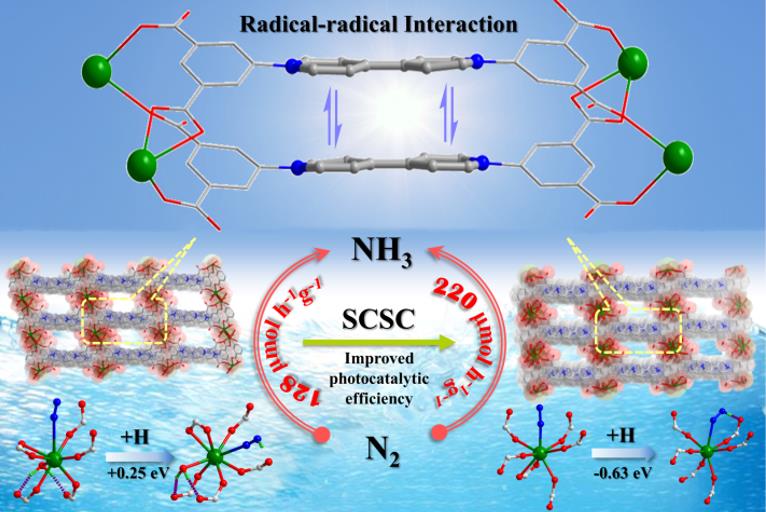Scientists Synthesize Two Novel Viologen-based Radical-containing MOFs
Professor Shi Weiqun's group from the Institute of High Energy Physics recently designed and synthesized two novel viologen-based radical-containing metal-organic frameworks (MOFs), Gd-IHEP-7 and Gd-IHEP-8. This represents an important advance in the field of photocatalytic nitrogen fixation using MOF materials. The study, entitled "Solar-Driven Nitrogen Fixation Catalyzed by Stable Radical-Containing MOFs: Improved Efficiency Induced by a Structural Transformation," was published in Angewandte Chemie International Edition.
As one of the most important discoveries of the 20th century, the Haber-Bosch process has greatly increased crop yields and promoted the development of the global economy. It remains the only process for industrial ammonia synthesis, but requires harsh conditions (e.g., Fe-based catalysts, 300-500 °C, 20-30 MPa) to improve ammonia yield. As a result, it consumes 1-3% of the world's electrical energy every year and emits a lot of greenhouse gases. Therefore, it is important to develop new ammonia production technologies, such as photocatalysis, which use less energy and are more eco-friendly. Among photocatalytic nitrogen fixation materials reported in the literature, MOFs offer great promise due to their high crystallinity, adjustable porous structures and easy modification.
In this study, structural analysis shows that Gd-IHEP-7 is a porous framework based on a 2D layered structure. Upon heating in air, Gd-IHEP-7 loses a coordination water molecule. This is accompanied by rearrangement of the Gd3+ coordination environment and a change from a 2D layered structure to a 3D porous framework, thus generating Gd-IHEP-8. Various characterizations show that a viologen ligand exists in the form of a stable radical in both radical-containing MOFs (RMOFs). Due to the presence of long-lived radicals and favorable radical-radical interactions, both RMOFs exhibit wide spectral absorption in the range of 200-2500 nm, suggesting excellent suitability for solar-driven nitrogen fixation. The ammonia production rates of the RMOFs were 128 and 220 μmol h-1 g-1, respectively, which represents an increase of 17 times in their solar-driven nitrogen fixation efficiency with MOFs.
More importantly, for the first time, researchers have clearly deciphered the mechanism for efficient nitrogen fixation via photocatalytic MOFs and the effect of MOF structure on nitrogen fixation efficiency, which is different than in traditional nitrogen fixation processes. Specifically, they discovered that during N2 reduction the intermediates for Gd-IHEP-8 have extra hydrogen bonds and lower free energy compared with Gd-IHEP-7, thus resulting in more facile nitrogen fixation by Gd-IHEP-8. To create these hospitable circumstances, the researchers adjusted the coordination environment around the metal nodes to enhance creation of the complexes' hydrogen bonding networks, thus improving the photocatalytic nitrogen fixation efficiency of MOFs. These results provide a new strategy for the design and development of novel nitrogen fixation photocatalysts based on MOFs, and suggest new applications for MOFs.
This project was supported by the National Science Fund for Distinguished Young Scholars and the General Program of the National Natural Science Foundation of China.

A single-crystal-to-single-crystal (SCSC) transformation of the stable radical-containing MOF Gd-IHEP-7 generates Gd-IHEP-8. This is accompanied by a marked increase in the efficiency of sacrificial agent-free photocatalytic nitrogen fixation to yield NH3 from H2O and N2 under simulated solar light irradiation at ambient temperature. The NH3 production rate of 220 µmol h-1g-1 for Gd-IHEP-8 is a new record for MOF photocatalysts. (Image by IHEP)
Contact Information
Mr. Guo Lijun
ljguo@ihep.ac.cn